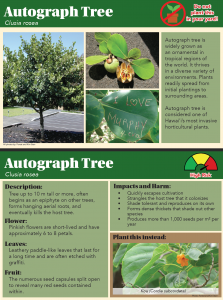Family: Clusiaceae
A widely planted invasive tree that spreads from its initial plantings.
Native to the Caribbean Basin, Florida Keys, and the Bahamas, Clusia rosea aggressively escapes cultivation. First documented as naturalized in 1934, this species remains a commonly used landscaping tree even as it invades both cultivated and natural areas. As a hemiepiphyte, this tree can grow from the ground or as an epiphytic strangler in a tree. Epiphytic strangling is evident in Hilo and Puna, especially near government buildings where native loulu palms are cultivated. Juvenile C. rosea trees grow out of the trunks of loulu; it remains to be seen how these native trees will fare with their unwelcome guests. C. rosea trees are a significant problem for homeowners. Fruit-eating nonnative birds disperse the seeds into rain gutters blocking the water passage and preventing catchments from filling up. To date, there are no known control measures besides mechanical removal. Autograph tree is a ‘no grow’ species for the Big Island Invasive Species Committee (BIISC) Plant Pono program. It is considered one of Hawaii’s Most Invasive Horticultural Plants.

Description and Dispersal:
- A tall tree up to 65 ft with smooth bark and epiphytic capability
- The thick leaves (6 in long by 5.5 in wide) are wider at the top and grow in an opposite pattern
- The pinkish flowers (2.5 in) grow in cluster up to 3 and are short lived
- Greenish brown, round seed capsules (3 in diameter) split into 8-9 parts revealing seeds within red plup
- Seeds dispersed by birds
High Risk Traits:
- Naturalized in Hawaiian Islands
- Thrives in tropical climates
- Spreads into unwanted areas and has the potential to become an environmental weed
- Sap and fruit are toxic
- Shade-tolerant
- Tolerates many soil conditions (and potentially able to exploit many different habitat types)
- Epiphytic strangler (may kill tree on which is grows)
- Can form dense thickets
- Apomictic
- Seeds dispersed by birds, and planted intentionally by people
Low Risk Traits:
- Palatable to goats
- Unarmed (no spines, thorns or burrs)
- Slow growing
- Landscaping and ornamental value




